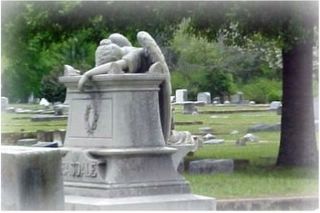
Twelve Gables,1838, Columbus, Mississippi
The first official observation of Memorial Day is said to have been held in Waterloo, New York on May 5th, 1866. However, in April of that year, a group of women in the Deep South had already decorated the graves of Civil War soldiers.
Columbus, Mississippi was not a military target during the Civil War. It was a center of food production for the Confederate troops, was briefly the state capital when Jackson fell and served as a military hospital center.
The antebellum home, Twelve Gables, built in 1838 was used as the primary military hospital in the area. On April 25, 1866, a group of women from the local women'’s association met at Twelve Gables and decided to lay garlands and flowers on the graves of the Confederate soldiers buried in the local cemetery, Friendship Cemetery. It is said that they marched with baskets of colorful flowers through the town to the cemetery. At that time the graves were not marked with stone markers and the majority of those buried were unknown..no name, no birth date.
Buried together with the Confederate soldiers were Union soldiers; those who died in the 1862 Battle of Shiloh. These women were tired of the war and were well acquainted with grief. Mississippi had 78,000 men who entered the Confederate military and by the end of the war 59,000 of them were either dead or wounded, 76%. Some records say over 2,100 Confederate soldiers are buried in Friendship and an unknown number of Union soldiers. These soldiers were their fathers, husbands, sons, and brothers. As they looked at the rows and rows of mounded earth, they decided to place flowers on ALL the graves, both Union and Confederate; after all, the Union soldiers were the fathers, husbands, sons and brothers of other women who were just as tired and just as sad as they.
In 1934, simple marble markers were installed. Approximately 350 are identified with names found in recovered records. The rest are labeled "“Unknown Confederate Soldier" or "“Unknown Union Soldier"”.
The kindness and empathy of the women in 1866 became known in other areas of the country and inspired the writing of the following poem by Frances Miles Finch, published in The Atlantic Monthly in 1867.
The Blue and the GrayToday, Friendship Cemetery, "Where flowers healed a Nation", is the final resting place for many local residents. Old marble carved markers from the 1800's mix with the shine of the modern memorials. The cemetery is on the National Register of Historic Places and is the setting for the annual "Tales from the Crypt" during the spring Pilgrimage. Students from Mississippi School for Math and Science research individuals buried here; write and present monologues based on their life stories. At dusk groups walk from station to station and hear the history of the people in this small southern town. The lighted path winds through the cemetery and past beautifully carved headstones, the most famous being the "Weeping Angel". I have heard the story that at different times of the day, the angel rests her head in different positions and that some have seen her face looking out over the graves. The ghost of a Confederate soldier is also said to march on guard duty towards the back of the cemetery. I have not seen either personally, but Columbus is full of such legends and ghost stories, especially with the large number of old antebellum homes. So, who knows?
By the flow of the inland river,
Whence the fleets of iron have fled,
Where the blades of the grave-grass quiver,
Asleep on the ranks of the dead:
Under the sod and the dew,
Waiting the Judgment Day;
Under the one, the Blue,
Under the other, the Gray.
These in the robings of glory,
Those in the gloom of defeat;
All with the battle-blood gory,
In the dusk of eternity meet:
Under the sod and the dew,
Waiting the Judgment Day;
Under the laurel, the Blue,
Under the willow, the Gray.
From the silence of sorrowful hours
The desolate mourners go,
Lovingly laden with flowers,
Alike for the friend and the foe:
Under the sod and the dew,
Waiting the Judgment Day;
Under the roses, the Blue,
Under the lilies, the Gray.
So, with an equal splendor,
The morning sun-rays fall,
With a touch impartially tender,
On the blossoms blooming for all:
Under the sod and the dew,
Waiting the Judgment Day;
Broidered with gold, the Blue,
Mellowed with gold, the Gray.
So, when the summer calleth,
On forest and field of grain,
With an equal murmur falleth
The cooling drip of the rain:
Under the sod and the dew,
Waiting the Judgment Day;
Wet with the rain, the Blue,
Wet with the rain, the Gray.
Sadly, but not with upbraiding,
The generous deed was done,
In the storm of the years that are fading,
No braver battle was won:
Under the sod and the dew,
Waiting the Judgment Day;
Under the blossoms, the Blue,
Under the garlands, the Gray.
No more shall the war-cry sever,
Or the winding rivers be red;
They banish our anger forever
When they laurel the graves of our dead!
Under the sod and the dew,
Waiting the Judgment Day;
Love and tears for the Blue,
Tears and love for the Gray.


Friendship Cemetery,Columbus, Mississippi, "Weeping Angel"

No comments:
Post a Comment